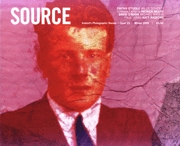They Must Be Represented
Beaches by Trevor Appleson was at Belfast Exposed, 2 - 23 Nov 2000
Review by Aaron Kelly
Issue 25 Winter 2000
View Contents ▸
Beaches by Trevor Appleson comprises a series of colour studio portraits shot on location at various beaches in and around the Cape Town area in South Africa. Appleson, a self-taught photographer who is originally from Johannesburg but now bases himself in London, resists using the beaches themselves as an avowedly natural and striking visual backdrop. lnstead, the portraits of his subjects, who range from the destitute to wide-boy gangsters and white professional-strata beach ravers, are produced in a portable studio using a mixture of sunlight and flash against a stark black background. The resultant photographs register a range of indifference, bemusement, embarrassment, enjoyment and cool repose amongst Appleson's subjects.
The radical decontextualization of these beach subjects from their environment may make several points. Firstly, it serves to foreground the artificiality of the representational process as such. lt may also suggest that this divergent array of people provide their own unique and contrary contexts to their individual lives. lndeed, the creative crux of Appleson's project resides in the tension between receiving this work as, conversely, deeply personal portraiture or pseudo-anthropological document. One photograph, of the homeless Marias Johan Meyer with his guinea pig, Bobo, points with self-referential prescience to the dangers of anthropological voyeurism that can inform the systematizing documentation of human specimens in this kind of project. Omar Jardine, 20, self-employed (gangster), Saunders beach
Omar Jardine, 20, self-employed (gangster), Saunders beach
Appleson's occlusion of the beach as a natural setting for the collection of social detritus shrewdly avoids a kind of 'beach combing', in his survey, in the sense of an aesthetic enhancement or grooming, which would divest this melange of people of the socio-economic division that still stratifies the beach areas of Cape Town and South African society more generally. Notably, beaches as political spaces were highly segregated metonyms of racial oppression and the Group Areas Act during Apartheid. Whilst Appleson's photographs attest to the diverse array of people now commingling in these areas, his use of a portable studio and its decontextualizing and avowedly neutral space is thus quite telling. For this voided backdrop intimates that a nascent, equitably multicultural and shared space in the new South Africa is yet to be enacted fully. Many of Appleson's subjects are homeless, unsure of their ages, birthplaces, even their names, so that their visual displacement in these beach portraits allegorizes the more concrete social dislocation of a people robbed of a history, a voice, a home. Goldfields, Sea Point Promenade
Goldfields, Sea Point Promenade
The stark displacement and erasure of context in Appleson's portraits lends a resonance to the evocative words of Ernst Bloch: ,lf human beings have grasped themselves and what is theirs, without depersonalization and alienation, founded in real democracy, then something comes into being in the world... where no one has yet been home'. So if these portraits represent the changing faces of South African society, then their hollow backdrop ruminates that more concrete and less cosmetic transformations are still required in constituting a properly shared social belonging.
Hopefully, therefore, the space in which South Africa reconciles itself and achieves social justice and equality is not proved to be the false representational space of postmodernity and its vacuous sense of pluralism and diversity, which designedly mystifies and decontextualizes all social and economic division. Appleson's collection of portraits and their blank contextual backdrop set the challenge of not only considering the former oppressions of Apartheid but also of inscribing a new and befitting context for his subjects. otherwise, as I think Appleson,s own sense of his positionality in this project affirms, Karl Marx's famous tenet will continue to resonate: 'they cannot represent themselves; they must be represented.'
Other articles by Aaron Kelly:
Other articles on photography from the 'Portraiture' category ▸






